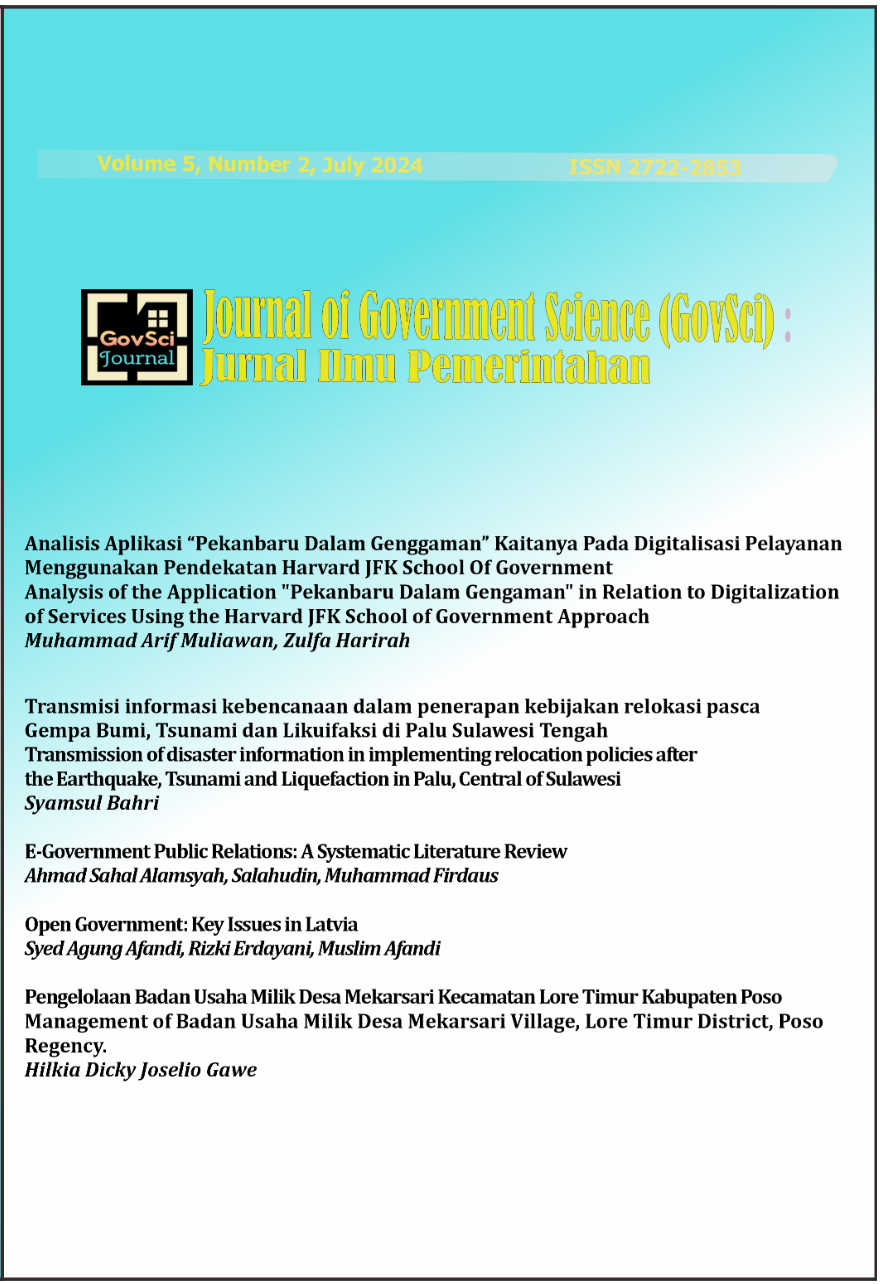E-Government Public Relations: A Systematic Literature
Abstract
This research aims to identify and describe the implementation of Government Public Relations based on digital technology or commonly referred to as E-Government Public Relations in a government system and can be used as study material. The research method used is qualitative research with a descriptive approach and a case study research model in conducting research regarding the implementation of E-Government Public Relations. What was applied in this research was a systematic literature review using 500 scientific articles sourced from the Scopus database. Review articles using the Vosviewer application. The research results reveal that E-Government Public Relations has a significant function and role in the activities and communication activities of government institutions which aim to improve services, meet public information needs and build and create a good communication climate between institutions and their stakeholders through various means. communication media platforms. Public Relations as a management function which aims to build, maintain and create quality communication, understanding and cooperation between an organization and its public, he also added that PR involves problem management or issue management, because PR is also responsible for assisting organizational management. The limitation of this research is that the articles used only come from the Scopus database so that the research findings cannot comprehensively describe the issue of digital transformation in e-government public relations. Future research needs to use scientific articles sourced from other reputable international databases, such as Web of Science and Dimensionds Scholars.
References
Balashov, AN, Lyseiuk, AM, Bashta, II, Shtelmashenko, AD, & Mykoliuk, AV (2020). Risks of social communications of public administrative bodies with regard to manifestations of corruption. Academic Journal of Interdisciplinary Studies, 9(6), 239–251. https://doi.org/10.36941/AJIS2020-0128
Batista, L., & Kawalek, P. (2004). Government Readiness to CRM Adoption: A Local Authority Analysis. 10th Americas Conference on Information Systems, AMCIS 2004, 2628–2637. https://www.scopus.com/inward/record.uri?eid=2-s2.0-85139083176&partnerID=40&md5=edfed8b14bd5b3e6cfcb63eec8150 317
Busch, P. A., & Henriksen, H. Z. (2018). Digital discretion: A systematic literature review of ICT and street-level discretion. Information Polity, 23(1), 3–28. https://doi.org/10.3233/IP-170050
Cardoso, H.R., da Silva, L.G., & Melo, B.L. da A. (2022a). E-government: administrative morality and the new public arena of the network society. Law of Justice Journal, 36(1), 45–73. https://doi.org/10.5335/rjd.v36i1.13461
Cardoso, H.R., da Silva, L.G., & Melo, B.L. da A. (2022b). E-government: administrative morality and the new public arena of the network society. Law of Justice Journal, 36(1), 45–73. https://doi.org/10.5335/rjd.v36i1.13461
Carrera-Mora, O ., Ovando, C., Villafuerte, L., & Parada, A. (2019). Citizens' perceived efficiency and its relationship with the use of e-government municipal services. Innovar, 29(74), 133–146. https://doi.org/10.15446/innovar.v29n74.82096
Cerrillo-i-Martí nez, A. (2011). The regulation of diffusion of public sector information via electronic means: Lessons from the Spanish regulation. Government Information Quarterly, 28(2), 188–199. https://doi.org/10.1016/j.giq.2010.05.009
De Oliveira Fornasier, M. (2021). The realization of e-democracy in the 21st century. Revista Da Faculdade de Direito Da Universidade Federal de Minas Gerais, 78, 259–283. https://doi.org/10.12818/P.03042340.2021v78p259
Dec man, M., Stare, J., & Klun, M. (2022). The impact of the COVID-19 crisis on the development of the information society in Slovenia. Administration Si Management Public, 2022(39), 77–96. https://doi.org/10.24818/amp/2022.39-05
Distel, B., & Lindgren, I. (2023). A matter of perspective: Conceptualizing the role of citizens in E-government based on value positions. Government Information Quarterly, 40(4). https://doi.org/10.1016/j.giq.2023.101837
Golubeva, A., & Merkuryeva, I. (2006). Demand for online government services: Case studies from St. St. Petersburg. Information Polity, 11(3–4), 241–254. https://doi.org/10.3233/ip-2006-0105
Haidu, H. (2020). TRANSFORMATION OF FORMS OF THE RIGHT TO OPPOSITION IN MODERN CONDITIONS. Evropsky Politicky a Pravni Diskurz, 7(2), 196–202. https://doi.org/10.46340/eppd.2020.7.2.26
Hariguna, T., Ruangkanjanases, A., & Sarmini. (2021). Public behavior as an output of e-government service: the role of new technology integrated in e-government and antecedent of relationship quality. Sustainability (Switzerland), 13(13). https://doi.org/10.3390/su13137464
Kassen, M. (2018). Adopting and managing open data: Stakeholder perspectives, challenges and policy recommendations. Aslib Journal of Information Management, 70(5), 518–537. https://doi.org/10.1108/AJIM-11-2017-0250
Kettani, D., Gurstein, M., & El Mahdi, A. (2009). Good governance and egovernment: Applying a formal outcome analysis methodology in a developing world context. International Journal of Electronic Governance, 2(1), 22–54. https://doi.org/10.1504/IJEG.2009.024963
Li, Y. (2010). Notice of Retraction: The research of personal customer relationship management for commercial banks: Based on multidimensional model of customer loyalty. Proceedings of the International Conference on E-Business and E-Government, ICEE 2010, 3168–3171. https://doi.org/10.1109/ICEE.2010.798
Mellouli, M., Bouaziz, F., & Bentahar, O. (2020). E-government success assessment from a public value perspective. International Review of Public Administration, 25(3), 153–174. https://doi.org/10.1080/12294659.2020.1799517
Nielsen, M. M. (2016). E-governance and stage models: Analysis of identified models and selected Eurasian experiences in digitizing citizen service delivery. Electronic Government, 12(2), 107–141. https://doi.org/10.1504/EG.2016.076132
Okunola, O. M., & Rowley, J. (2019). User experience of e-government: the Nigeria Immigration Service. Library Hi Tech, 37(3), 355–373. https://doi.org/10.1108/LHT-09-2018-0138
Pors, USA (2015). Becoming digital – passages to service in the digitized bureaucracy. Journal of Organizational Ethnography, 4(2), 177–192. https://doi.org/10.1108/JOE-08-2014-0031
Santos, HR, Tonelli, DF, & De Souza Bermejo, PH (2014). Sociopolitical digital interactions' maturity: Analyzing the Brazilian states. International Journal of Electronics Government Research, 10(4), 76–93. https://doi.org/10.4018/ijegr.2014100104
Splendore, S. (2016). Media use, political participation and the level of digitization: A comparative analysis of EU countries. Partecipazione e Conflitto, 9(1), 211–232. https://doi.org/10.1285/i20356609v9i1p211
Toleikiene , R., Juknevic iene , V., & Rybnikova, I. (2022). Electronic leadership at local self-government: conceptual analysis and literature review. Public Policy and Administration, 21(1), 111–128. https://doi.org/10.5755/j01.ppaa.21.1.29709
Xiao, Y., Xiao, M., & Zhao, H. (2007). An ontology for e-government knowledge modeling and interoperability. 2007 International Conference on Wireless Communications, Networking and Mobile Computing, WiCOM 2007, 3605– 3608. https://doi.org/10.1109/WICOM.2007.891
Authors
Copyright (c) 2024 Ahmad Sahal Alamsyah Jajuli, Salahudin Salahudin, Muhammad Firdaus

This work is licensed under a Creative Commons Attribution-ShareAlike 4.0 International License.

